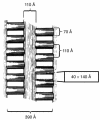What determines glomerular capillary permeability?
- PMID: 15545991
- PMCID: PMC525751
- DOI: 10.1172/JCI23577
What determines glomerular capillary permeability?
Abstract
There have been exciting recent advances in our understanding of the structural and molecular biology of the glomerular slit diaphragm, as described in a report in this issue of the JCI. These findings, combined with data on the permeability of the basement membrane and evidence that the endothelium may be a more important barrier than often supposed, are allowing a clearer understanding to emerge of how the 3 parts of the glomerular capillary wall jointly determine its functional properties.
Figures


Comment on
-
Nephrin strands contribute to a porous slit diaphragm scaffold as revealed by electron tomography.J Clin Invest. 2004 Nov;114(10):1475-83. doi: 10.1172/JCI22562. J Clin Invest. 2004. PMID: 15545998 Free PMC article.
References
-
- Lazzara MJ, Deen WM. Effects of concentration on the partitioning of macromolecule mixtures in agarose gels. J. Colloid Interface Sci. 2004;272:288–297. - PubMed
-
- Blouch K, et al. Molecular configuration and glomerular size selectivity in healthy and nephrotic humans. Am. J. Physiol. 1997;273:F430–F437. - PubMed
-
- Daniels BS, Hauser EB, Deen WM, Hostetter TH. Glomerular basement membrane: in vitro studies of water and protein permeability. Am. J. Physiol. 1992;262:F919–F926. - PubMed

